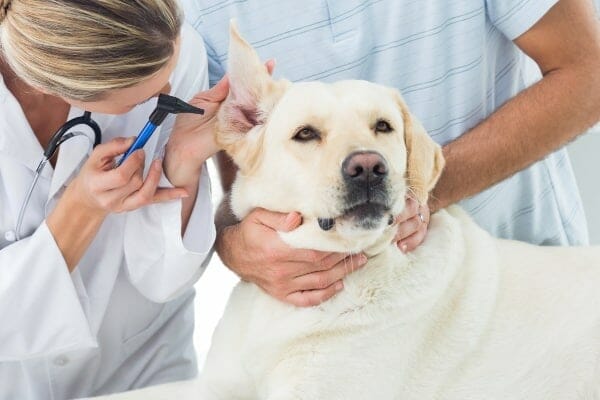My older dog is trembling and can’t walk
As you can see, the causes as to why a dog is trembling and cant walk can affect a dog of any age. However, there are mitigating factors in the development of these symptoms. Generally speaking, trembling occurs more often in older dogs. This is due to the deterioration of a dogs body over time, but may also be related to specific experiences and traumas.
Although trembling in dogs can occur on any part of the body, they are particularly associated with the hind legs. This is because degeneration or trauma can affect various parts of the spine, but the sections furthest away from the skull have more opportunity to be affected. This localization hinders mobility and will explain why your dog is trembling, falling and cannot hold themselves up normally.
The degeneration of a dogs body due to age not only affects their musculoskeletal system. It can also affect neurological function, resulting in systemic problems. Physical degeneration of bones and joints can affect gait and posture, but neurological degeneration can affect many number of bodily systems.
An example of this is cognitive dysfunction syndrome in dogs, a syndrome similar to Alzheimers disease in humans. This syndrome can affect dogs over 10 years old and includes the deterioration of their mental faculties. Dogs that suffer from this may present:
We suggest visiting a veterinarian who can arrive at a diagnosis and treat the animal accordingly.
It is important to remember that with age there are many dogs that suffer from osteoarthritis. This is disorder caused by joint inflammation which results in trembling and lack of walking. The exhausted muscle will naturally tremble as it fights the urge to move.
There are different types of arthritis in dogs. They are not usually curable, but there are medications that can relieve pain and manage other symptoms. It is also advisable that a dog with this disease exercises moderately, maintains a controlled diet and is offered an adequate, comfortable and warm resting place.
Lastly, a dog can also tremble and not want to move due to trauma caused by a blow or accident. As with the previous cases, it is pain that prevents the animal from making any movement, so it is very important to try and locate the damaged limb or body part and visit a veterinarian.

Causes of generalized tremors and incoordination in dogs
There are various reasons for trembling in dogs. While they will mostly be due to physiological issues, psychological or emotional trauma can result in trembling. The latter doesnt usually prevent the dog from walking, so paralysis and incoordination is usually due to a physical issue.
The reasons why your dog is trembling and cant walk include:

If your dog trembles and falls, it is most likely due to one of the above problems. It is essential you go to the veterinarian as soon as possible. A vet will be able to determine the cause of the problem and treat it accordingly. In many cases, an early diagnosis means the difference between life and death.
Causes of ear infections in dogs
Otitis interna (inner ear infections) and otitis media (middle ear infections) can be caused by:
Sometimes, external ear infections can extend into the middle and inner ear. In those cases, affected dogs will also show signs of external ear infections. These include debris in the ear canal, head shaking, or ear scratching. Other times, the external ear canal will be completely normal.

A variety of conditions can affect the brain or brainstem, causing central vestibular disease. Affected dogs tend to have vertical nystagmus (eyes moving up and down) rather than horizontal.
In addition to the other symptoms of vestibular syndrome listed previously, they may have impaired or dull mentation. This means they are slow to process information or respond to stimuli, are unaware of their surroundings or are not acting like themselves. Seizures may also occur.
Infection, inflammation, or brain tumors (tumors of the brain or brainstem) are the most common reasons for a dog to develop central vestibular syndrome signs. Infections may be caused by bacteria, fungi, viruses, or protozoa. Many of these same causes can also affect the cerebellum, causing cerebellar ataxia.
Sometimes a dog will be wobbly and off balance and show other vestibular signs that are not related to hypothyroidism in dogs, tick-borne diseases in dogs, or any of the other causes discussed above. We call this idiopathic vestibular disease. The other name for it is old dog vestibular disease because it happens more commonly in older dogs.
In fact, it also happens to be the most common cause of vestibular disease overall. The good news is that signs often resolve over a period of a few days with supportive therapy. So if there is a “good” type of vestibular syndrome, it is this one.
To learn more about old dog vestibular disease, please refer to my article, Old Dog Vestibular Disease: A True Story About Doggy Vertigo. Also, if your dog has been diagnosed with any of the causes of vestibular disease, you might find these 10 Tips and Exercises for Dogs with Vestibular Disease helpful.
While strokes are less common in dogs than in humans, they do still happen occasionally. Strokes occur when blood flow to the brain is disrupted due bleeding or an obstruction in a vessel. Without the oxygen, glucose (fuel for the brain), and other blood components, the brain doesn’t function correctly. As a result, a dog may be wobbly and disoriented or show other vestibular syndrome signs.

You can read my article, Dog Stroke Symptoms & Treatments in Senior Dogs to find out more.
Anything that damaged or disrupts the spinal cord can cause spinal ataxia. This is the case in IVDD (intervertebral disc disease) in dogs. In this condition, disc material leaves its normal position between two vertebrae (bones in the spine) and starts to press on the spinal cord.
When the spinal cord is compressed, nerve signals have trouble moving past the affected area. In some cases, a vet may recommend IVDD surgery for dogs. Other times, non-surgical IVDD recovery in dogs is possible.
Spinal stroke in dogs is another condition that may cause a dog to be wobbly and off balance. The other name for this condition, fibrocartilaginous embolism (FCE), gives a clue about how it occurs.
A piece of intervertebral disc material (a fibrocartilaginous substance) breaks off and blocks one of the blood vessels that nourishes the spinal cord. When blood supply is obstructed (i.e. an embolism occurs), the portion of the spinal cord supplied by that vessel is damaged.
Some ataxic or disoriented dogs have external injuries that might point to a known or suspected traumatic event as the cause of the signs. The brain and spinal cord can be damaged by :

Head trauma causes damage to the neurons and bleeding and swelling in the brain. If there is swelling in other parts of the body, it isn’t as big of a deal. For example, a leg has space to expand outward when it swells. Not so much with the brain since the skull is a fixed size.
As the brain swells and blood builds up around the brain, the pressure in the skull (intracranial pressure) increases, compressing the brain tissue. This makes it harder to get the blood through the vessels in the brain.
Without the blood supplying needed nutrients and oxygen, brain function declines and the dog may become depressed or disoriented. Cerebellar and/or vestibular ataxia will also occur if either of those systems are damaged.
Spinal cord trauma will cause spinal ataxia since the neurons are damaged by the initial injury and the body’s response to the injury. In severe cases, the dog may even be paralyzed.
Lastly, a variety of toxic substances can cause a dog to be wobbly and off balance. They may also cause other neurologic signs like seizures or tremors, as well as heart, lung, kidney, liver, or gastrointestinal signs.

Toxins to suspect include:
Other toxins not on this list are also capable of causing neurologic signs and some intoxications may be fatal. Anytime you suspect your dog may have ingested a toxic substance, immediately contact your veterinarian or the ASPCA Animal Poison Control Center. (Please note, there is a consultation fee charged for the ASPCA’s services.)
What Do Dog Tremors Look Like?
Realizing “My dog is wobbly and off balance” can be disconcerting for even the most seasoned dog parent. Integrative veterinarian, Dr. Julie Buzby, dives deep into the heart of your dog’s nervous system to explain the “why” behind the loss of balance and seven conditions that could be the culprit.
What should you do if your dog is staggering around like he or she spent a bit too much time on a merry-go-round? The answer—take a calming breath, then call your vet. Let him or her know, “My dog is wobbly and off balance.”
I understand how unnerving it can be to watch your beloved dog lose balance and even stumble around. I’ve witnessed these signs in my own canine patients, and I’ve felt my clients’ concerns along with them.
That’s why I want to share seven reasons a dog may be wobbly and off balance. But first, let’s dive into some nervous system anatomy so we can better understand what’s going on with a wobbly dog.